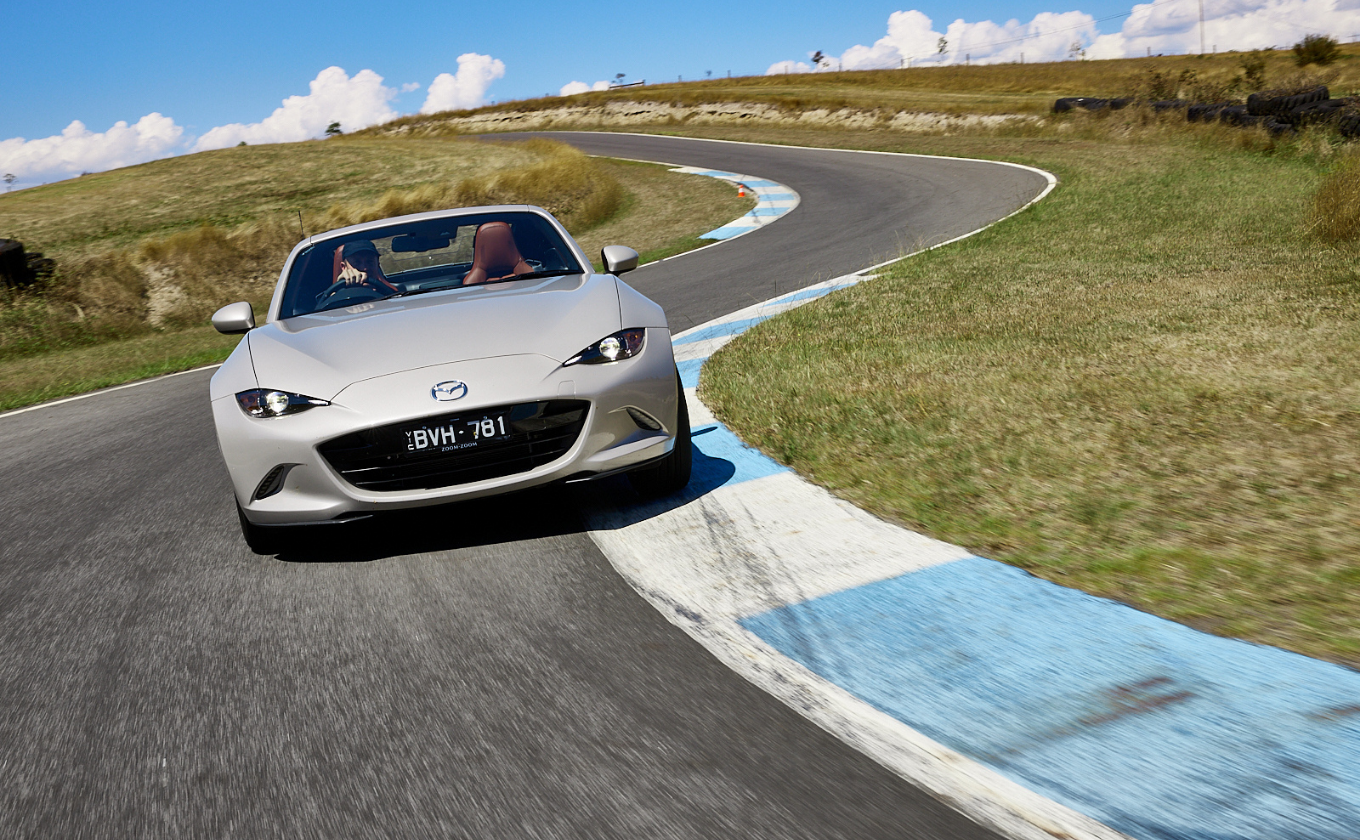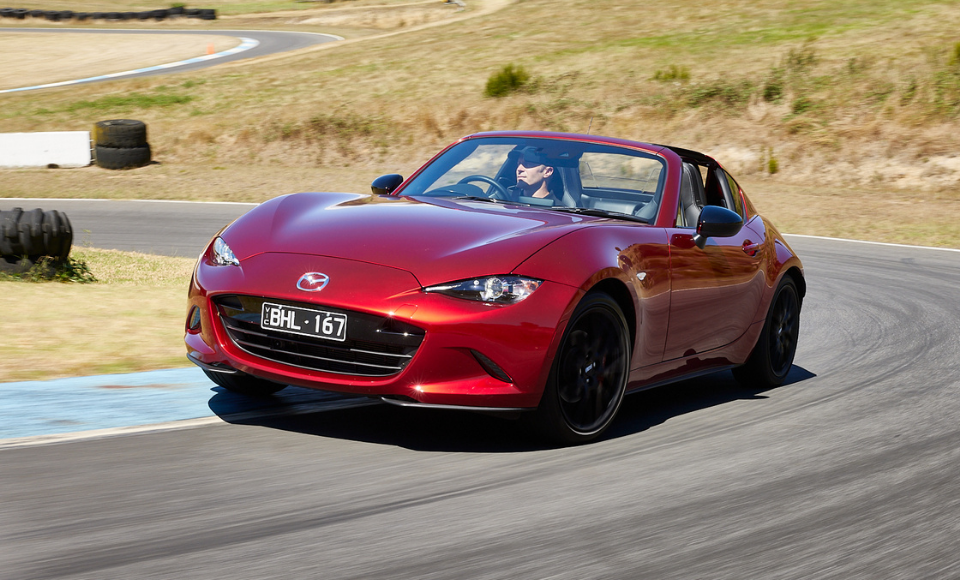Mazda MX-5
Small but mighty updates make for an even sharper drive
Seriously, how did human beings, with our many obvious flaws and amusing-looking bodies, rise to become the dominant species on this planet?
Some scientists point to the size of our brains (elephants and whales tap their vast noggins and chuckle ruefully), others to our opposable thumbs, our ability to socialise and empathise or our incredible adaptivity and inventiveness.
Personally, I think our passionate desire for improvement has a lot to do with it. We humans are just never satisfied, always looking for a better way. Sure, fire must have been impressive at first, but in a relative blip of geological time we were shooting it out the bottom of rockets to the moon.
You also see this in less scientific fields of human endeavour, like running 100 metres very quickly. Early humans had to outrun cheetahs, or try to, but it’s hard to know how fast they were in bare feet. As the 1900s dawned, no one had gone faster than 10.6 seconds, but we’ve slashed an entire second off that since then, and Usain Bolt’s once impossible to imagine 9.58 record will surely fall one day, because somewhere there is a human who thinks they can do better.
With all this in mind, it should come as no surprise that modern car engineers, and particularly the madly passionate ones who work on Mazda’s halo car, the magical Mazda MX-5 roadster, continuously find ways to improve on their previous efforts.
Yes, obviously each new model of the Mazda MX-5 makes a big step from the last one, as it is largely reinvented, and the ND version, launched some seven years ago, took some bold leaps in terms of design, in particular, turning a wide-eyed, smiley-faced machine into something meaner and more masculine.
Since then we’ve seen a hard-top roofed model, the RF, launched in 2016, and high-output 2.0-litre engined variants arriving in 2018. The last time this writerdrove an MX-5 was barely a year ago, and it struck me then that Mazda had come perilously close to perfecting the breed - light weight, rear-wheel drive, sun on your skin, short wheelbase, sharp handling - it just ticked all the boxes.

You can tell when a car company is confident that it has something to show off, firstly when it invites you to a race track to drive its new model - a location like the Haunted Hills Hillclimb circuit in Victoria leaves a car no place to hide - and secondly, when it gives you the chance to drive its new model back to back with the old one.
Clearly, this MY22 version of the world’s best-selling roadster must have something special about it, and it’s not going to be visible to the naked eye.
That new feature is called Kinetic Posture Control, or KPC, and what you need to know is that it really does make a difference to the way this already incredibly fun car can attack corners, and that it makes more of a difference the harder you push it.
Basically, on a tight, twisting and undulating track like Haunted Hills, the old car is a lot of fun and can be thrown at corners with some abandon before you get any sense of the tyres being tortured or grip running out.
Jump into the new MY22 version, however, and it’s immediately noticeable just how much faster and sillier you have to be hurling yourself into corners before the tyres even begin to chirp. It just feels even more planted to the road, more reassuring and, unfortunately for my slightly concerned looking co-driver/instructor, encourages you to really push your own limits.
So what is Kinetic Posture Control, and what witchcraft is it applying to the MX-5 to raise its already high levels of handling to another plane?
Well, in technical terms, “KPC uses the MX-5’s double wishbone suspension layout to provide a more integrated and stable turn-in posture at higher speeds”, which almost sounds simple enough, but it also “senses the wheel speed difference across the rear axle in real time and increases its response rate linearly in order to generate the posture stabilisation effect accordingly.”
In what you might call marketing terms, it “optimises the MX-5’s driving capabilities over a wider bandwidth” and gives “a greater sense of oneness” between driver and car.
It’s hard to argue with that last description, to be fair, but in the simplest terms of all, KPC works by applying braking to in the inner rear wheel when cornering, which suppresses both pitch (the car’s nose dropping under braking) and body roll.
Cleverly, the car’s rear suspension has also been designed with an active “anti-lift” system, that means the body stays flat under hard braking so that you don’t lose grip, or control, even at track speeds.
What all of this is allowing you to more fully enjoy, particularly around the tight, g-force maximising track that is Haunted Hills, is the MX-5’s sharp steering, short wheelbase, the amazing gear shifts from its six-speed manual (long may it reign) and the natural balance and pure joyousness of its rear-wheel-drive layout.

Why is rear drive so much better for sports cars, and driving in general? Well, here’s a simple way to explain it, through the beautiful language of interpretive dance.
Next time you’re busting a move, try to dance using only your shoulders and chest, but not your hips. You can wave your hands in the air, if you want to. Even without embarrassing yourself thusly, you know it’s just not going to work. You need to put your hips into it, and it’s the same with a car.
Because the MX-5 is rear-wheel drive - meaning all of the power is sent to the back wheels, all the time - driving it feels fluid, natural and just better. It’s like you can feel its hips dancing, ever so slightly (or quite a lot if you fancy drifting) right behind you.
There are some simple, scientific reasons that rear-wheel drive equals sheer driving pleasure, of course. Imagine trying to carefully print your name while using a chainsaw; it’s just asking too much of your hands, right?
Well, in a front-wheel-drive car you’re asking the tyres at the front to put power to the ground and do the steering, and that’s just never going to be optimal. If you put the power of an F1 car through its front wheels, it would pull your arms off before smashing you into a wall.
Leaving the rear wheels to get the power down and the front ones to do the steering creates the perfect balance, and maximum driver involvement.
Speaking of F1, of course, brings us back to that endless thirst for improvement that defines our race. Did you know that, over the course of an F1 season, each car gets faster and faster, often by a few seconds a lap, and that if your team isn’t constantly improving its vehicle, every single week, you’d be miles behind by season’s end?
That same thirst to take something that seems, at first blush, to be as perfectly constructed as it could possibly be, and make it even better, is the reason that I know that, as crazy as it seems, the next MX-5 will be even better than this one.
I can’t wait to try it.